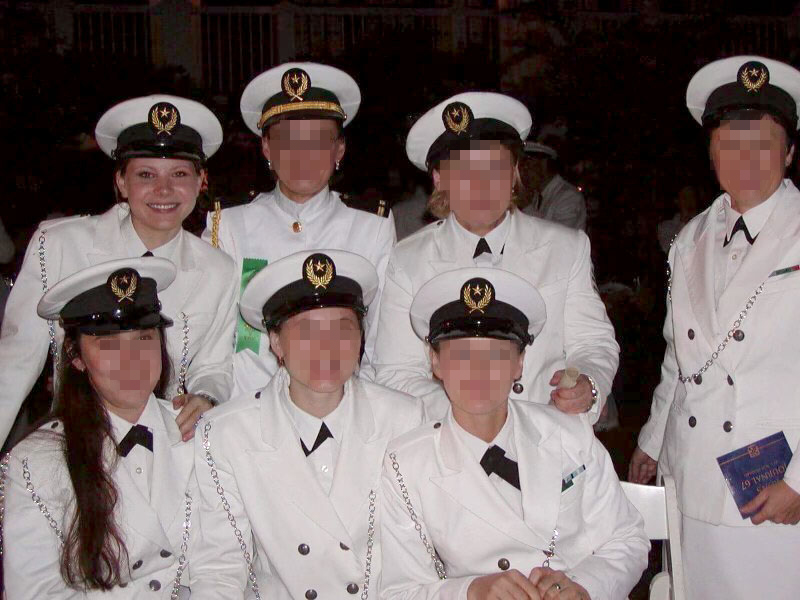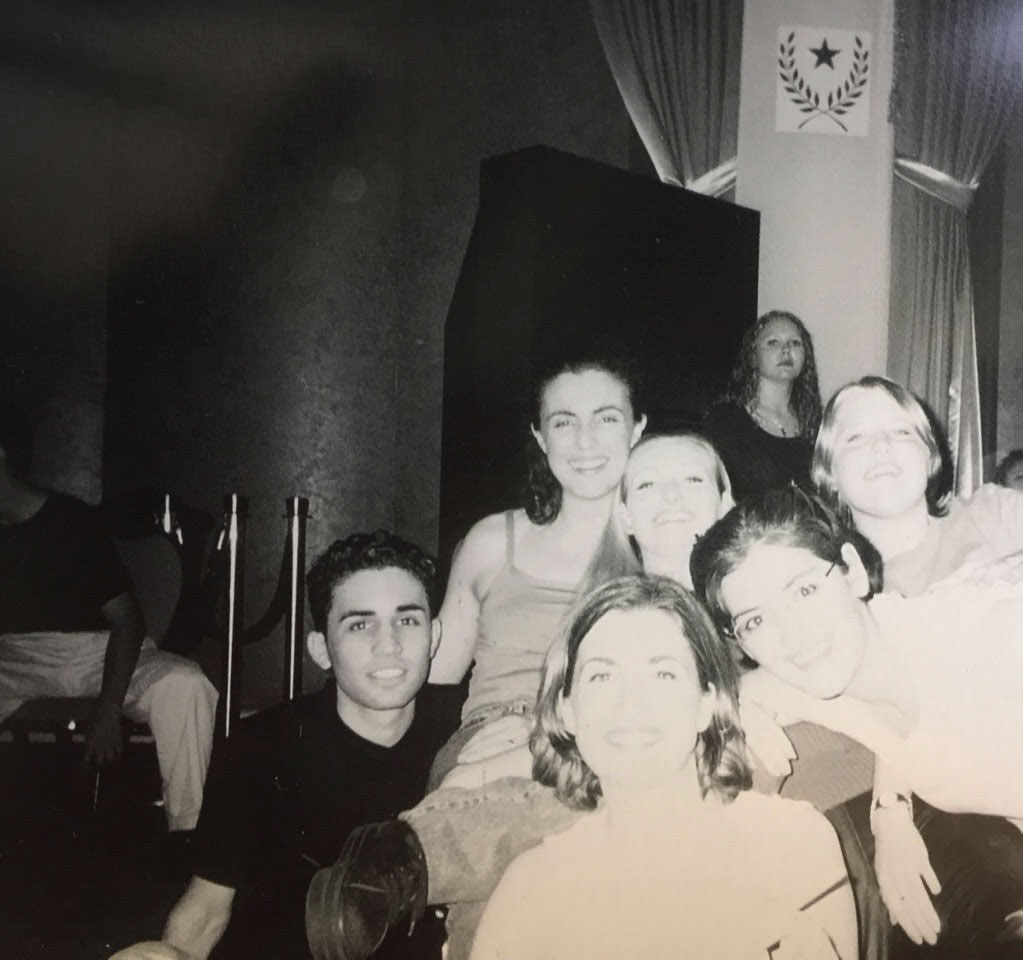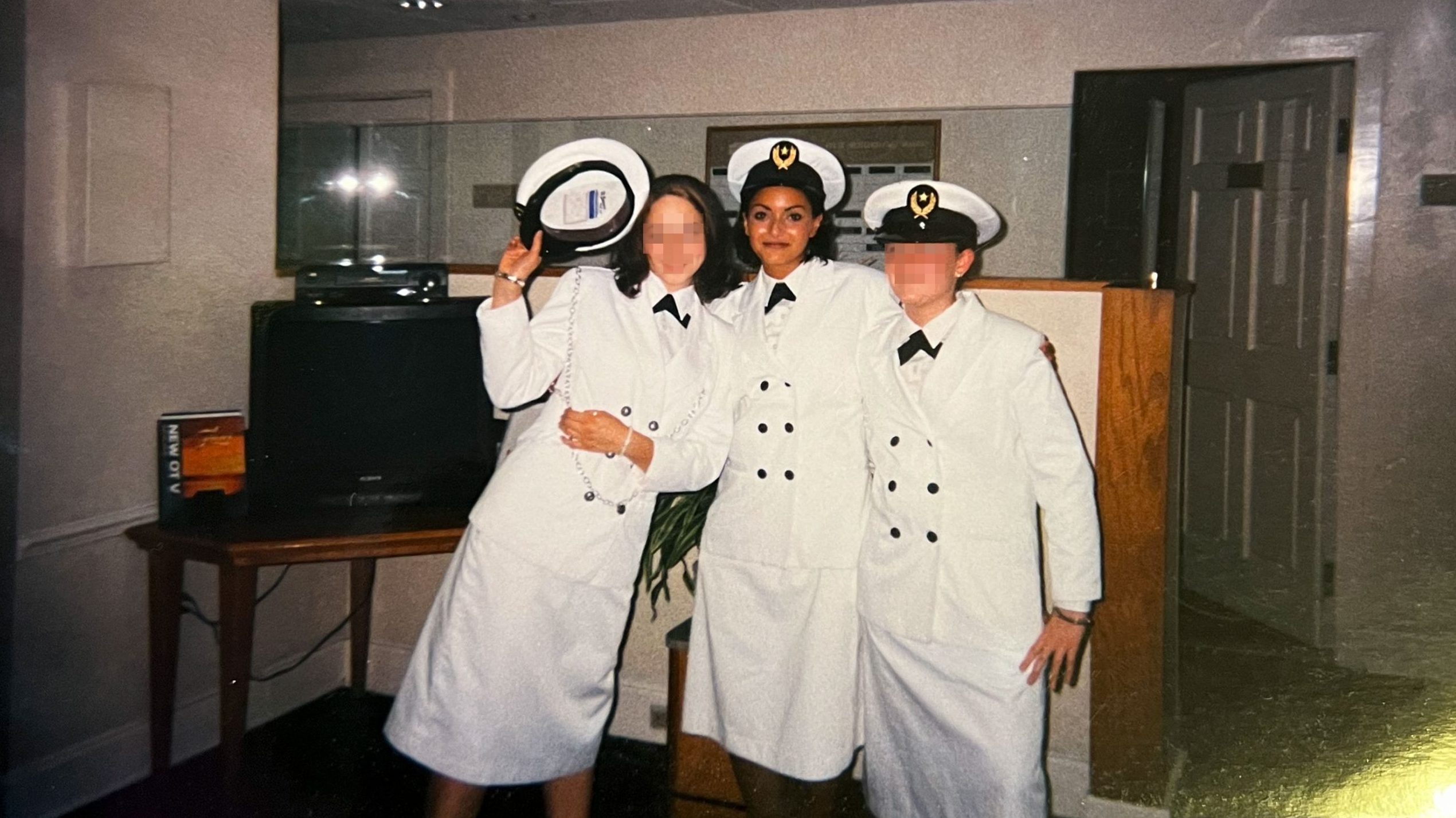This story was co-produced with New York Magazine
England, 1994. Tina* was 14. Her parents lived at Scientology compounds in the United States, and church officials wanted Tina to come join them by using an R-1 visa — a permit recently created by Congress for religious workers, good for five years. The officials told Tina what to tell anyone who asked: that she would be attending a special Scientology school and volunteering for the church part time. It wasn’t true. Once approved, Tina worked shifts as long as 24 hours doing construction, building furniture, and performing administrative tasks. “None of it’s voluntary,” she told me.
Hungary, 1997. Attila Sonkoly, then 21, was getting as many as five calls a day from Scientology officials urging him to come work for the organization in the U.S. on an R-1 visa. He finally agreed, and to help him pass his interview, the recruiters shared a psychological profile of the person who would screen him at the U.S. Consulate. The visa was approved, and soon Sonkoly was off to Clearwater, Florida, where Scientology has one of its headquarters. An official there took away his passport and made him sign contracts in English, a language he didn’t understand. Sonkoly saw that what he’d been instructed to tell the consulate — that he’d be performing religious duties as a minister — was a lie. “They needed us to do disgusting work,” he said, and “very, very heavy manual labor.” He estimated that two-thirds of the people working in Clearwater were from overseas.
Canada, 2001. Haley Keldani, then 17 and living near Vancouver, was fielding calls from a recruiter who wanted her to get an R-1 and move to Clearwater. Her parents were Scientologists and had sent her there a year earlier to take classes; during the visit, Keldani says, she was raped in a pool by a man in his 40s. Church officials had made her take responsibility and punished her. (A spokesperson said, “There was no report of rape to the Church.”) Now the recruiter was telling her exactly what to say to pass her R-1 interview. After getting the document and entering the U.S., Keldani was taken to do demolition work at a property the church owned. Several men were struggling with a heavy roll of industrial carpeting, and they handed the job off to Keldani and another girl. “I fucking destroyed my spine and my neck,” Keldani says. Today, she regards Scientology’s operation in Florida as a forced-labor camp. “This was clearly slave work,” she said. “The R-1 visa itself was false. There was no religious volunteering taking place. I was not a minister. I’d never done any minister certification or training. I was just a young girl.”

For the past year, I’ve been corresponding with more than three dozen former Scientologists hailing from 12 countries on five continents. Some joined the church when founder L. Ron Hubbard was still running the show; some left as recently as last summer. Whenever I asked them to talk about their time inside the organization, they didn’t dwell much on Tom Cruise, volcanos-and-aliens cosmology, or any of the sensational stuff that gets the most attention. What they talked about was rules, bureaucracy, jargon, and quotas. The work. For those who were part of Scientology’s operations, especially those who were part of the clergy, known as the Sea Org, their lives revolved around labor. They cleaned, cooked, landscaped, provided child care, stood guard, did construction and demolition, and performed a variety of tasks that brought in money to the church, all for little to no pay. At Scientology bases around the U.S., called orgs, laborers live in dorms and work shifts that are often as long as 16 hours, though a few told me the sessions can stretch beyond 24 hours without breaks to sleep. Over and over, my sources described how feeling unable to leave their orgs or refuse arduous work assignments was akin to involuntary servitude, even slavery.
Scientology isn’t a popular religion; Stephen A. Kent, a professor at the University of Alberta who studies the church, puts its global size at no more than 30,000 people. But it is a rich one, with assets thought to be in the billions, including prime parcels of real estate in major cities like New York and Los Angeles. The money flows in from its own members in the form of fees for audits (a kind of confessional) and courses that are required to rise higher in the church. Pressure campaigns induce believers of every economic class to donate their life savings. In the U.S., though, Scientology has long had a crippling image problem that makes it difficult to attract new members domestically.
To boost numbers, church leaders have recruited thousands of people from abroad, making heavy use of the R-1 visa program — a strategy that is all but unknown to the general public and has never been fully scrutinized. Federal rules specify that R-1 applicants must have been a member of a given religion for two years and must promise that they are coming to the U.S. to work “solely as a minister or to perform a religious vocation or occupation.” But former Scientologists told me that church officials instructed them to give statements about their work to immigration officials that would clear them to obtain a religious visa — then, once they arrived, found themselves doing nonreligious work for extended periods of time. Such activity could expose Scientology to liability on a number of fronts. “If a person is being hired to do administrative work and was coached to pretend that it’s religious in nature, then that would be fraud,” says Michael Wildes, an immigration expert who served as a federal prosecutor in Brooklyn for four years.
Wildes singles out the line rehearsing and rote memorization exercises that Tina, Sonkoly, Keldani, and other workers told me they engaged in with Scientology officials ahead of their visa interviews. “If they were making sure that the individual stayed on message, then that would be acceptable conduct. But if they were charging them to say things that were just not truthful, that would be actionable,” he says. According to Wildes, even if some of the workers went on to perform ministerial work for Scientology, that does not bear on the secular physical and manual labor they performed. “There’s no window of time where you’re doing menial stuff for a year and then you get religious content,” he says. “It has to be religious content from the beginning.”
Other former prosecutors agree. “You’re talking about people who were bricklayers and scrubbing toilets and things like that. Those are not religious functions. Those are not religious jobs. Not at all,” says Theodore J. Murphy, a former prosecutor for the Department of Homeland Security. “The individual who’s coaching them to do that could be involved in a conspiracy, which is also a criminal charge.”
Every former Scientologist I spoke with who came from a foreign country told me that, after they arrived at a U.S. org, they had their passports, visas, and other travel and identifying documents taken by church officials. “You are now truly an undocumented person,” says David Spaulding, who spent 23 years as an Immigration officer, most recently overseeing investigations for a branch of the Fraud Detection and National Security Directorate for U.S. Citizenship and Immigration Services. “You do not exist. You can’t go to the police. You can’t talk to a social-services person. You can’t buy milk. ‘We own you.’”
A coordinated program to bring in foreign workers in the ways the former Scientologists describe would be enough for federal investigators to open a fraud inquiry, according to Wildes. “If they can prove that there’s a pattern and practice of doing this,” he says, “they could shut down the whole church from being able to avail themselves of the R-1 religious-worker program.”
That would be an enormous blow to the church’s operations, especially because Scientology’s ability to tap this labor pool has already been imperiled by the pandemic. In 2021, along with several other religious organizations, Scientology officials formally co-signed a letter to the director of U.S. Citizenship and Immigration Services describing the slow pace of visa approvals during the COVID era a “crisis” and calling for looser restrictions to make them easier to obtain. There is good reason to suspect that this slowdown has strained the operations and finances of the church. Financial documents recently made public show that its main Florida base lost money in 2020.
Karin Pouw, a spokesperson for Scientology, said by email that the organization “strictly complies with U.S. immigration policies” and “works directly with immigration counsel to ensure compliance with the immigration policies and regulations of the United States.” She added that my sources were liars engaged in a “coordinated and premeditated conspiracy to level false allegations.” Scientology has successfully defended itself in court against allegations of worker abuse before. In 2009, Marc and Claire Headley, a married American couple who spent more than a decade in the Sea Org, sued the church for human trafficking, claiming that the organization had stolen their wages, forced them into manual labor, and forced Claire to abort two pregnancies. A federal judge in California dismissed the case, saying the church was protected by a ministerial exception to labor laws. The Ninth Circuit upheld the ruling, writing that the Headleys could have left the religion at any time and that the statute they sued under, the Victims of Trafficking and Violence Protection Act, pertained to “transnational crime.”
Compared to the Headleys, foreign workers — especially those who were brought into the U.S. as children — may have a stronger case. In April, three former Scientology members, who were born abroad and drafted into the Sea Org as minors, filed a civil lawsuit against the church and its leader, David Miscavige. They allege violations of laws against trafficking, forced labor, peonage, and conspiracy. (The church has not presented a full defense at this stage of the case and is seeking to move the matter to arbitration. It has denied that it broke U.S. law, saying that many of the allegations took place in the Caribbean or beyond statutes of limitations.) Because of the litigants’ age at the time in question, it’s unclear what type of visas they possessed. But their lawsuit, which was filed in U.S. District Court in Florida, makes similar claims to those I heard from former Scientologists with R-1’s over a span of decades.
One of the plaintiffs, Gawain Baxter, who was born in Australia, alleged that he was “required to perform physical labor, including renovating a building, cleaning other facilities, and landscaping for 12 or more hours per day” at a rate of $8 to $50 a week. His wife, Laura Baxter, claims that she was “required to spend eight to ten hours per day performing arduous physical labor, including digging trenches, cleaning toilets and dumpsters, and landscaping,” and was paid roughly $25 a week. The third plaintiff, Valeska Paris, says church officials “made her clean the premises for 12 to 18 hours per day, including requiring her to climb into and scrub garbage dumpsters with toxic chemicals without protective gear.” Her weekly pay, she says, was $15.
“That’s just insane,” says Kent Williams, a litigator known for successfully representing hundreds of workers in a wage-theft lawsuit against Chipotle. “Prisoners make more than that.” How much value Scientology derived from immigrant workers is a matter of conjecture, relying on a significant number of variables: how many hours per week they worked, for how many years, at what nominal pay, and so on. But labor lawyers specializing in wage-theft cases do attempt to make such calculations. Four of these experts (Nicole Hallett, the director of the Immigrant Rights Clinic at the University of Chicago Law School; Daniel Costa, the director of immigration law and policy research at the Economic Policy Institute; David Cooper, the director of the Economic Analysis and Research Network at EPI; and Williams) agreed that based on estimates provided by former Scientologists, CIS data, and tax documents obtained by sources, over the past 30 years Scientology’s use of foreign workers has probably saved the church hundreds of millions of dollars and potentially more than $1 billion.
“We came on tourist visas.”
Scientology’s reliance on immigrant labor is nearly foundational, going back to the early years of the religion. In 1967, 14 years after the church’s founding, the IRS revoked its tax-exempt status after determining that Hubbard had unjustly enriched himself. In response, he founded the Sea Org, sailing outside U.S. jurisdiction with his closest followers on a trio of ships. They hoped to spread the religion globally, getting people’s minds to “clear,” or become free of pain and anxiety. But the voyage was an extended disaster with foreign practitioners of the religion getting banned in the U.K. In 1975, Hubbard and his crew quietly returned to Clearwater, and it was there that the organization’s cat-and-mouse game with the U.S. immigration system appears to have begun.
“This all started when we first came to the U.S. from the Apollo,” says Mike Rinder, who was born in Australia, referring to one of Hubbard’s vessels. “We came on tourist visas and were drilled and briefed to tell Immigration, if they asked, that we were just coming in for a short vacation and that we all had return tickets. But then we just stayed.” Rinder rose in seniority over the years, becoming head of Scientology’s Office of Special Affairs and a spokesman for the church. He left the organization in 2007, disturbed by, among other things, its activities involving immigration and labor. “I do believe that it is fraud,” Rinder says.
After Congress created the R-1 visa category with the Immigration Act of 1990, Scientology’s leaders seemed to quickly see its value. The permit’s rules hold that religious organizations are not obligated to pay R-1 workers, though they usually have to provide some kind of non-salaried compensation, which can be just room and board. According to former immigration officials, getting one of the visas involves making relatively few financial disclosures to the government. They’re valid for a long time, up to five years, and the holder has a clearer path than some other immigrants to getting a green card.
The Church of Scientology is sprawling, comprising hundreds of corporations and nonprofits, and different parts of the organization embraced the R-1 at different times. The Sea Org in Florida seems to have been the first, according to interviews with people brought over on the travel documents. By 1992, church leaders were evidently willing to go to some length to ensure access to the visas. That year, after a Scientologist’s visa application was rejected several times in Greece, OSA officials formulated a plan to turn the situation around. Written in the militaristic jargon of the church, a memo discussing the strategy included a reference to “black propaganda” (the act of smearing a perceived enemy) and instructions to meet with a certain consular official and potentially “blow his withholds off” (expose personal secrets).
Scientology had its tax-exempt status reinstated by the IRS in 1993, and the following year, officials in Florida helped a 14-year-old Mexican named Serge Gil get an R-1. “They had a person who handled what to say, how to coach, what lawyers to go to — everything,” says Gil, whose parents were Scientologists. “They were cocky. They were like, ‘We just became a religion, I’m going to write you this letter, it says that you are a minister-in-training.’” He signed a billion-year contract with the Sea Org, as is custom. “It’s not hyperbole,” Gil says. “It took a long time for me to understand I was a slave.”
Clearwater officials sent instructions on obtaining visas to its bases abroad. One of the people who saw the directives firsthand was Peter Bonyai, a former Sea Org officer who worked in Budapest during the 1990s and 2000s. “There was a lot of pressure because they saw it as an easy way to quickly get a lot of people,” he says. Bonyai recalls Clearwater officials faxing “fabricated” letters claiming that workers were needed from Budapest because there was a large population of Hungarian-speaking Scientologists in America who required their assistance. “They didn’t really need people from Hungary to serve Hungarian Scientologists,” Bonyai says. “They just needed the workforce. That was a cover story.” After prospects sat for interviews with consular officials, Bonyai says, they would report back on the questions they were asked and what answers seemed best. Those details went into scripts for future applicants. (Pouw, the spokesperson, said that Bonyai “was not involved in the immigration of any Hungarians for Church staff.)
Clearwater officials instructed overseas orgs to focus their recruitment. “They were headhunting for very specific crowds and very specific people,” says Kirill, a member of Scientology from 2006 to 2018 who worked for the Moscow org. (He asked that his last name be withheld.) The people they targeted, he says, came from “humble backgrounds, no English at all, no job, but no big obligation to their family, no credit-card debt, no mortgages.” Kirill says he was personally involved in efforts to coach visa applicants, helping to translate scripts they could memorize from English into Russian. The Moscow Org also kept track of which consulates were easiest to get visas from — Moscow was considered more difficult than Vladivostok, St. Petersburg, or Yekaterinburg — and would sometimes send people to former Soviet satellite countries where immigration officials were perceived as less exacting.
Prospective workers were told that Scientology was a gateway to a better life — a path to fulfillment on a personal, professional, or spiritual level. Recruiters’ pitches varied by target. Men might forge emotional relationships with young women. “They would hit on young girls and make them fall in love with them, because they’re both hot, and then get them in the Sea Org with the impression that they would date,” one female ex–Sea Org member, who worked at compounds in Florida and Venezuela, told me. For another woman, who says she came to the U.S. from Canada at about 13 years old, the pitch was an education for a career in designing buildings. “I joined on the premise that I would be immediately put into some kind of architecture program and have the possibility of designing their buildings,” she says. “I bought it, and it was a complete lie. It was just slave labor.”
Recruits told me they were shown pictures of nice living quarters and had no idea they would be working brutally long hours. Many also thought they wouldn’t be required to believe in the tenets of Scientology. “One of the big selling points is that you can supposedly — and this is completely not true — be any religion and not be Scientologist,” says an American, a former member of the religion who worked with recruiters in California. After reality hit, some disappeared — or tried to. The American, who worked in L.A., described witnessing church officials post people at the nearest train station to keep an eye out for anyone trying to leave. “They’re new to this country and have no idea what’s happening.”

Russia, 1999. Ekaterina Tikhonova, 11, and her mother, Yelena, were living in the freezing and prospectless Siberian city of Barnaul. Her grandmother had converted to Scientology while on a trip to Florida a few years earlier, and she pushed her daughter and granddaughter to join the religion as a way to attain prosperity. “She sold the American Dream,” Tikhonova says. “Just the thought of going from Siberia to America? Sold. Right then and there.”
Tikhonova’s meeting with U.S. Immigration officials was at the end of the summer at the U.S. Embassy in Moscow. In the days before the appointment, her grandmother coached her on what questions she would face and how she was to answer, especially regarding whether she would be likely to leave the U.S. when the visa expired. “She wasn’t acting like a grandmother. She was acting like a Sea Org member,” Tikhonova says. “I was drilled and drilled and coached and coached to answer the question without stumbling or anything. I was really scared going into the interview. I was 11 years old, and I knew I had to lie.” On her grandmother’s advice, Tikhonova even brought pictures of their family to the interview to persuade Immigration officials that their stay would be temporary, she says. (Efforts to contact Tikhonova’s mother and grandmother for comment were unsuccessful.)
Tikhonova passed the interview. After about a week and a half, she was off to Clearwater, where she began working eight hours a day — housekeeping, doing construction, and preparing food in an industrial kitchen. She was also required to study Scientology doctrine for an additional five hours a day. Living conditions were cramped in dorms where tiles fell off the walls and carpets were dirty. At first, she and her mother shared a room with bunk beds, but after her mother became a member of the Sea Org, they were separated, and Tikhonova was only able to see her mother at meals a few times a month. When Tikhonova persisted in complaining about living and working conditions, her mother filed a report on her. That landed Tikhonova in what is known as “ethics handling,” where members are subjected to interrogations that can last for hours. Tikhonova was also made to clean toilets and scrub an industrial dumpster. “It seemed like a prison camp,” she says.
For the next few months, her contact with her mother was limited to the five or ten minutes she would get to see her at meals. One day Tikhonova told her mother that she wanted to get legally emancipated and leave the compound. “Her response was, ‘Where are you gonna go? Who’s gonna take you?’ Then I felt like I was stuck. After a month of literally just being punished and punished by getting interrogated and everything else and then getting assigned even more hard manual labor — because now I’m quote-unquote in trouble — I felt like they just wore me out mentally and physically to the point that I just gave in. I was like, ‘Fine. Whatever. I’m wrong for wanting to actually have a fucking relationship with my mother. I’m wrong. I’m wrong. Absolutely wrong. I confess.’ I just realized at that point that I have no choice. By then I’m 12. I have no place to go. I’m in the United States. We didn’t speak a lick of English when we got here. We have no family here, no friends, a brand-new country. The only thing I can do is go back to Russia. I have extended family there, but who’s going to take me? I’m a financial burden. I’m a child. So I felt like I was just stuck. I had no other choice.”
Tikhonova passed her Scientology classes and eventually worked as an administrative assistant to an auditor, making sure that people arrived at their auditing sessions on time. In 2006, she went back to Russia to acquire a new passport. During the trip, she says, she was raped by two men. Back in the U.S., Scientology officials grilled her for days, asking her questions about the incident over and over again. When she stopped cooperating, Scientology expelled her from the church. She had a green card that allowed her to stay in the U.S., but she decided to return to Moscow. She had no money of her own and thought she would have ended up homeless in America.
“What they do with immigrants is they threaten them all the time,” says Tikhonova, who eventually changed her name to Katrina Reyes. “And that’s exactly what they did with me.”

As immigration laws have changed, so have Scientology’s tactics to protect its flow of foreign workers. In 2006, a report by the Government Accountability Office singled out the R-1 visa program as ripe with opportunities for fraud, and federal authorities set about overhauling the program. Scientology officials submitted three letters of objection. One was signed by Glen E. Stilo, whom Rinder and other sources described as a major figure in Clearwater’s R-1 program. Stilo’s letter challenged nearly every major alteration that the government was considering. He sought to reduce the level of training ministers would have to attain and opposed a regulatory change that would define “religious vocation” as involving duties that differ from those performed by secular members of a congregation. In his letter, Stilo acknowledged that “a small percentage of our religious order perform work at our retreat that may not be considered a ‘religious functions,’ such as administrative work unique to the ministry section of our church, or upkeep of church property and grounds.” The letter included a line that hinted Scientology would challenge any Citizenship and Immigration Services regulations it didn’t like on the grounds of the separation of church and state: “It appears that C.I.S. is treading on dangerous unconstitutional entanglement ground.” The next year, 2008, the agency abandoned a number of the proposed revisions that would have strengthened its rules around what a religious vocation is.
An FBI report from 2009 noted that as many as half of the Sea Org’s workforce came from abroad. Other government records give a detailed look at Scientology’s extensive pursuit of R-1s in the period that followed. According to CIS data obtained by the researcher RM Seibert through Freedom of Information Act Requests, which was first published by the journalist Tony Ortega, church officials submitted as many as 4,160 applications for R-1 visas from 2009 to April 2017. (This is a count of I-129 forms, which can involve other kinds of visas besides the R-1. But many former Scientologists told me that church officials’ use of those other visa types was negligible.) Each case must be approved twice: first by CIS, then by the State Department. Former government officials and Scientology insiders told me that, for some countries, CIS approved nearly every file. (CIS data show that since 2017, the overall approval rate has been above 90 percent.)The State Department’s standard was tougher — it green-lit about 80 percent of all religions’ R-1 applications during the period in question, according to its published reports. A spokesman declined to provide information about the success rate for Scientology specifically. But if the 80 percent figure applied to the church, it would mean that in these years, the relatively tiny faith won nearly 9 percent of all R-1 visas granted globally.
What counts as religious work is not a straightforward matter, complicated by the broad latitude that the First Amendment gives to religious institutions to define their faith and practice. The State Department’s Foreign Affairs Manual provides that religious visas can be granted not only to people with specific occupations, like priests or cantors, but also those who have committed their lives to religious vocations — people like monks and nuns. It says their work can be “any type of activity within their religious vocations, denomination, or its affiliate”; the manual goes on to say that the emphasis for granting the visas is on a person’s status in an organization, rather than the content of their work. While this would appear to open the door for religions to deem any work done in their name as religious, both Wildes and Spaulding say that isn’t the case. “No immigration application or lawyer will ever contemplate any work being permitted,” Wildes says. “A religious worker visa is exactly that: for religious work. Nothing more would be permitted. It would be a breach of immigration law.” Spaulding says that while it’s up to a religion to define its own practices, that doesn’t mean the State Department is then required to issue visas to everyone who claims to be doing religious work. They both said that people who might not be able to consent to a devotional life — such as children, people who didn’t understand what they were signing up for, or those who joined under duress — might also not be permitted by the State Department.
Russia, where groups linked to Scientology have been declared “undesirable” by the government, seems to have been a particularly fruitful recruiting ground. “Every time someone says, ‘I am an oppressed category in Russia,’ we approve it without even blinking. Doesn’t even occur to us that it might be a problem,” says David Spaulding, the former federal Immigration officer. (A CIS spokesperson said that a person’s nationality doesn’t factor into whether an R-1 applicant will receive a visa.) Church officials submitted as many as 660 R-1 visa applications tied to Russia during the 2009–17 period. CIS signed off on 637. It’s not clear how many the State Department then awarded final approval, but the total number of R-1 visas it granted to Russians is strikingly close: 649.
Data from after 2017 is not publicly available, but around that time, Scientology’s appetite for R-1 visas seemed only to be increasing. In 2016, the church’s San Diego branch asked the U.S. government for permission to sponsor the work permits, as the headquarters in Clearwater had done. A former Scientologist who visited the org at the time, working as a training supervisor, says that like other sites, it depended on foreign labor to operate. “Recruiting local Scientologists was a pain in the ass,” she says. “It was a lot easier to get people in from Eastern Europe, Mexico, South America.”
Immigration officials scheduled an R-1 sponsorship inspection for the end of 2016 and later granted approval. Afterward, the training supervisor says, a leader of the San Diego operation circulated a memo to other sites detailing how to successfully prepare for government inspectors. “Really specific shit,” she says. “What wording you have to use, how you have to describe it, what jobs are eligible for an R-1, what jobs can be made to sound as if they’re eligible for an R-1.” (A CIS spokeswoman did not respond to questions about the inspection. A State Department spokesperson wrote in an email, “The Bureau of Consular Affairs takes all allegations of fraud seriously and works aggressively to ensure the integrity of U.S. visa and passport adjudications and all consular services we provide worldwide.”)
TestPost3
There isn’t a lot of case law on religious-worker-visa fraud, but one recent dispute has parallels with some of the accusations made by former Scientologists. Last year, a group of Indian workers filed a class-action suit against a Hindu organization in New Jersey, alleging that it trafficked people to the U.S. on R-1 visas under the guise of religion when they were actually there to help construct temples. According to the complaint, the sect — Bochasanwasi Shri Akshar Purushottam Swaminarayan Sanstha, or BAPS — instructed the workers to tell Immigration officials that they would do decorative painting and carving, while in reality they did construction and stonemasonry. The plaintiffs also alleged that their passports were confiscated. BAPS has said in court filings that it did nothing wrong. The day the suit was filed, the FBI raided the temple, and a judge has stayed the case while the Justice Department investigates.
For decades, scrutiny of Scientology has tended to focus on the outrageous and the glamorous, missing how the church aggressively used an obscure visa program and created a pool of exploited laborers numbering in the thousands. This blind spot even seems to extend to law enforcement. In 2018, Serge Gil met with investigators at the FBI and Department of Homeland Security in Los Angeles to discuss human trafficking. He hasn’t heard anything since. The same year, Mike Rinder says, he met with an Immigration and Customs Enforcement agent in Tampa Bay to raise similar concerns. He also doesn’t know if investigators have acted on his information.
For decades, the R-1 visa has been a starting point for thousands of people coming into the United States looking for a better life, or a new spiritual beginning, before spending years doing back-breaking work for Scientology. Even those who’ve managed to leave the church have had to deal with the traumas from their lives inside: suicide attempts, depression, forced separation from their families, a feeling of displacement from the world. “When people think of Scientology, they think Hollywood, they think funny, they think aliens, they think it’s a big joke,” says Haley Keldani, the Canadian who says she was raped and suffered an injury performing heavy labor. “I spent the last 19 years pretending that never happened so I could try to fit into society and be normal. This has to be stopped. People need to know this exists.”
*Tina is a pseudonym.












